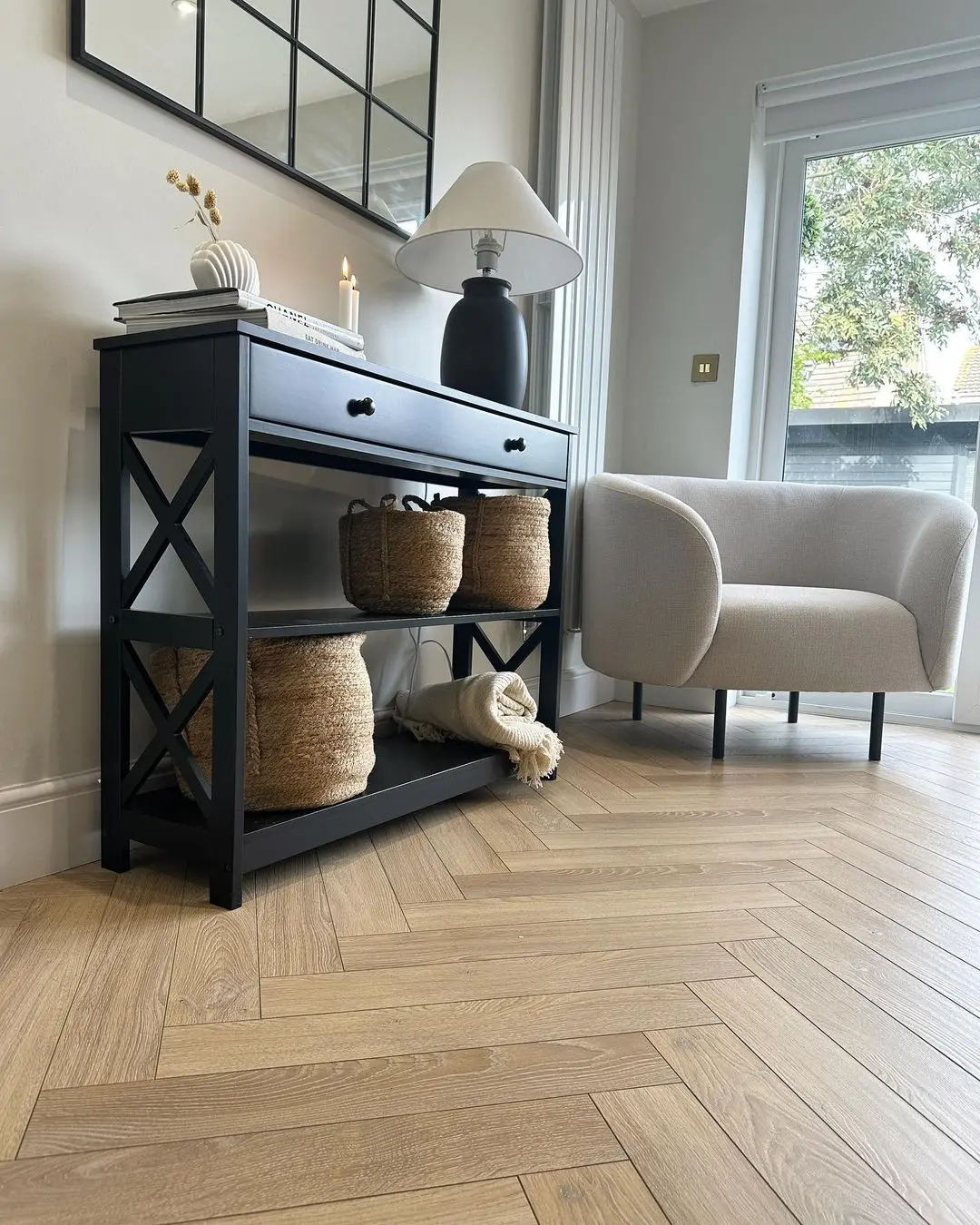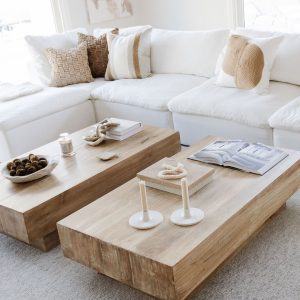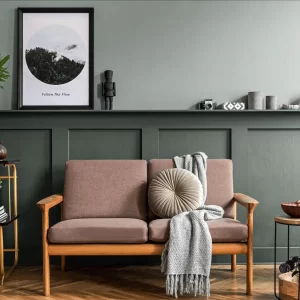‘How to Avoid Common Mistakes When Selecting Home Flooring‘ guides you through making informed decisions to ensure your home decor reflects your style without the typical pitfalls.
Understanding Your Needs: Matching Lifestyle with Flooring
Before diving into the vast sea of flooring options, it’s crucial to assess the functionality of each room in your home. The right flooring choice can not only enhance the beauty of your space but also ensure it meets your daily needs.
Here’s how to align your flooring with the function of each room:
- Living Room and Common Areas: These spaces are high-traffic zones where the aesthetics and durability of your flooring matter most. Consider materials that withstand heavy use while maintaining their appeal.
- Kitchen and Bathrooms: Moisture resistance is key in these areas. Look for flooring that can handle spills, humidity, and easy cleaning.
- Bedrooms: Comfort and warmth underfoot are desirable. Soft, plush carpets or warm hardwood can add coziness to your private retreats.
- Basements and Utility Rooms: These areas require durable and moisture-resistant flooring, possibly with added insulation against cold concrete subfloors.
Considerations for Lifestyle and Household Activity Levels
Your lifestyle and the activities that occur in your home significantly influence the type of flooring that will best suit your needs.
Reflect on the following points:
- Pets: If you have furry friends, scratch-resistant and easy-to-clean flooring options should be your go-to choices.
- Children: Look for non-slip, soft, and durable floors that can withstand spills and energetic play.
- Allergies: Consider flooring that doesn’t harbor dust mites or allergens. Hard surfaces can be a better option over carpets.
- Entertaining: If you love hosting, choose a flooring type that not only impresses but can also withstand the wear and tear of heavy foot traffic.
Exploring Flooring Options: From Hardwood to Carpet
With a clear understanding of your needs and how they translate to different areas of your home, it’s time to delve into the array of flooring options available. Each type comes with its own set of pros and cons, making it important to weigh these factors against your specific requirements.
Here’s a rundown of the most popular flooring types:
Hardwood
Pros:
- Timeless appeal and elegance
- Increases home value
- Durable with proper care
- Can be refinished
Cons:
- Susceptible to scratches and water damage
- Higher cost
- Requires regular maintenance
Laminate
Pros:
- Mimics the look of hardwood at a lower cost
- Easy to install and maintain
- Resistant to scratches, making it pet-friendly
Cons:
- Not as durable as hardwood over time
- Can warp in high moisture areas
- Cannot be refinished
Tile
Pros:
- Ideal for wet areas like kitchens and bathrooms
- Durable and water-resistant
- Wide variety of designs
Cons:
- Hard and cold underfoot
- Grout lines can be difficult to clean
- Installation can be challenging
Carpet
Pros:
- Soft and comfortable underfoot
- Excellent for sound insulation
- Wide range of colors and textures
Cons:
- Can stain and harbor allergens
- Not suitable for high moisture areas
- Requires regular vacuuming and professional cleaning
Vinyl
Pros:
- Water-resistant and durable
- Mimics the look of wood, tile, or stone
- Easy to clean and maintain
Cons:
- Can emit volatile organic compounds (VOCs) initially
- Not as valuable as hardwood or tile in terms of investment
- Susceptible to cuts and tears
Budgeting Wisely for Your Home Flooring Project
When it comes to selecting home flooring, budgeting is a critical step that goes beyond just the cost per square foot. It’s about understanding the full scope of your flooring project, from materials to installation and beyond.
Here are some essential tips and considerations to help you budget wisely for your new floors.
I. Initial Costs vs. Long-Term Value
- Material Costs: Different flooring options come with varying price tags. Hardwood floors are typically at the higher end of the spectrum, while laminate and vinyl offer more budget-friendly alternatives. Consider not just the upfront cost but also the longevity and value addition to your home.
- Installation Expenses: Some flooring types, like tile and hardwood, often require professional installation, which can significantly add to the overall cost. On the other hand, options like laminate and certain types of vinyl offer the possibility of DIY installation, potentially saving you money.
II. Hidden Costs to Watch Out For
- Underlayment and Prep Work: Depending on the current state of your floors, you might need underlayment or prep work before installing the new flooring, which can add to the overall cost.
- Delivery and Waste Disposal: Don’t forget to account for the cost of having materials delivered to your home and the disposal of your old flooring.
- Tools and Supplies: If you’re planning a DIY installation, you’ll need the right tools and supplies, which can add to your budget.
III. Budgeting Tips
- Get Multiple Quotes: Whether you’re purchasing materials or hiring professionals for installation, getting several quotes can help ensure you’re getting a fair price.
- Plan for Extra: It’s a good practice to purchase a little more material than you calculate you’ll need to account for mistakes or future repairs. This can prevent the scenario of running out of matching flooring if it’s discontinued.
- Consider Financing Options: Some retailers offer financing plans that can help spread out the expense of new flooring. Make sure to read the fine print and understand the terms before committing.
Durability and Maintenance: Ensuring Long-Lasting Floors
The longevity of your flooring is influenced not just by the material you choose but also by how well you maintain it. Understanding the durability needs of your space and the maintenance required for different types of flooring will help you make a selection that stands the test of time.
Assessing Durability Needs
- High-Traffic Areas: Entryways, hallways, and living rooms see a lot of foot traffic. In these areas, consider materials known for their durability, such as hardwood, tile, or high-quality vinyl.
- Moisture-Prone Spaces: Kitchens, bathrooms, and basements require flooring that can handle moisture well. Tile, vinyl, and certain laminate options are designed to withstand these conditions.
- Pet-Friendly Flooring: If you have pets, look for scratch-resistant and easy-to-clean options. Some laminates, vinyl, and harder woods (like oak and maple) are more resistant to pet wear and tear.
Maintenance Requirements
Each flooring type comes with its own set of care instructions. Here’s what you need to know to keep your floors looking their best:
- Hardwood: Requires regular sweeping or vacuuming and occasional mopping with a wood cleaner. Avoid excessive water. Consider refinishing every 7-10 years to remove scratches and restore shine.
- Laminate: Easy to clean with sweeping and damp mopping. Avoid using steam cleaners or wet mopping, which can cause warping.
- Tile: Sweep or vacuum regularly. Mop with a mild detergent. Grout may need periodic cleaning to prevent staining and maintain appearance.
- Carpet: Vacuum at least once a week to remove dust and allergens. Professional cleaning is recommended every 12-18 months to deep clean and extend the life of your carpet.
- Vinyl: Sweep regularly and mop with mild detergent. Avoid abrasive cleaners, which can damage the surface.
Long-Term Care Tips
- Use Protective Measures: Floor mats at entrances can reduce the amount of dirt and moisture tracked onto your floors. Furniture pads can prevent scratches from chairs and heavy furniture.
- Immediate Spill Cleanup: Regardless of your flooring type, clean up spills as soon as they happen to prevent stains and damage.
- Regular Inspections: Keep an eye out for signs of wear and damage, such as cracking, peeling, or warping. Early detection can prevent more significant problems down the line.
Aesthetic Considerations in Home Flooring Choices
The aesthetic appeal of your flooring plays a significant role in defining the overall ambiance of your home. It can complement your decor, make a space feel larger or cozier, and reflect your personal style.
Here’s how to make aesthetic considerations a part of your flooring selection process:
I. Matching Flooring with Home Decor and Style
- Consider the Overall Theme: Whether your home has a modern, traditional, rustic, or eclectic style, choose flooring that complements or enhances this theme. For instance, wide-plank hardwood floors might complement a rustic decor, while polished concrete or large-format tiles could enhance a modern aesthetic.
- Color Coordination: Flooring color can significantly impact room aesthetics. Lighter floors can make a room feel more spacious and airy, while darker floors can add warmth and drama. Consider the amount of natural light a room receives when deciding on floor color.
- Texture and Pattern: The texture of your flooring can add depth and interest to a room. For example, hand-scraped hardwood, textured laminate, or patterned tile can add a tactile dimension to your space. Patterns, whether in the form of tile layouts or the natural grain of wood, can add movement and flow to your interiors.
II. Importance of Color, Texture, and Pattern in Flooring Selection
- Color: Think about the mood you want to create. Warm tones can create a cozy atmosphere, while cool tones can evoke a calm, serene feel. Consider the color of your walls and furniture to ensure a harmonious palette.
- Texture: Smooth floors can offer a clean, minimalistic look, while textured surfaces can deliver rustic charm or an organic feel. The right texture can also help conceal dirt and wear, making it a practical consideration.
- Pattern: The pattern of your flooring can become a statement piece, especially in rooms with simpler decor. Intricate patterns, such as those found in some tile work, can add a significant visual impact.
Environmental Impact and Health: Eco-Friendly Flooring Solutions
In today’s world, more homeowners are considering the environmental impact and health implications of their flooring choices. Eco-friendly flooring options and materials that promote good indoor air quality are becoming priorities.
Here’s how to make selections that are both good for your home and the planet.
I. Eco-friendly Flooring Options
- Bamboo: Fast-growing and sustainable, bamboo flooring is a popular choice for environmentally conscious homeowners. It’s durable and comes in various styles.
- Cork: Harvested from the bark of cork oak trees without harming the tree, cork flooring is biodegradable, comfortable underfoot, and has natural insulation properties.
- Reclaimed Hardwood: Using reclaimed hardwood not only adds unique character and history to your home but also reduces the demand for new timber.
- Linoleum: Made from natural materials like linseed oil and wood flour, linoleum is durable, biodegradable, and comes in a variety of colors.
II. Health Considerations
- Low VOC (Volatile Organic Compounds): Select flooring materials that emit low levels of VOCs to ensure better indoor air quality. Many manufacturers now offer low-VOC options for laminate, vinyl, and engineered wood flooring.
- Allergy-Friendly: Hard surface flooring, such as hardwood, tile, and vinyl, can be easier to keep free of allergens like dust mites, pet dander, and pollen compared to carpet.
- Non-Toxic Underlayments and Adhesives: When installing new flooring, opt for non-toxic underlayments and adhesives to further reduce potential health risks.
III. Making Informed Choices
- Research and Certifications: Look for certifications like the Forest Stewardship Council (FSC) for wood products, which ensure the wood is sourced from responsibly managed forests. For other materials, check for GREENGUARD or FloorScore certifications, indicating low chemical emissions.
- Consider the Lifecycle: Think about the production, installation, maintenance, and eventual disposal of the flooring. Choosing materials that are durable and recyclable can minimize environmental impact.
- Balance with Other Factors: While environmental and health considerations are important, balance them with other factors like durability, maintenance, and aesthetics to make a choice that fits all your needs.
Measuring and Ordering: Avoiding Common Flooring Mistakes
Accurate measurement and strategic ordering are crucial steps in the flooring selection process, ensuring you have enough material for your project while minimizing waste and extra costs. Here’s how to navigate this phase effectively.
Tips for Accurate Measurement
- Room Shape and Size: Start by drawing a simple diagram of the room, noting any alcoves, nooks, or irregularities. Measure the length and width of the room at the widest points, multiplying these figures to get the total square footage. For oddly shaped rooms, divide the space into smaller rectangles or squares, calculate the area of each, and then add them together.
- Account for Waste: It’s advisable to purchase an additional 5-10% of material to account for cutting waste and mistakes. For patterned or directional flooring, like some hardwoods and tiles, consider buying 15-20% extra to match the pattern correctly.
Ordering Extra
- Future Repairs: Having extra flooring on hand can be a lifesaver for future repairs or expansions. Flooring batches can have slight color variations, so flooring from the same batch ensures a perfect match.
- Discontinued Lines: Flooring styles and materials can be discontinued. Purchasing extra ensures you have matching materials for any future needs without having to replace an entire floor.
Avoiding Common Measuring Mistakes
- Not Considering Thresholds and Closets: Remember to measure the space under doors and inside closets, as flooring typically extends into these areas.
- Ignoring the Details: Details like the direction of the plank or tile can impact the amount of material needed. Plan your layout in advance to determine the most efficient and aesthetically pleasing direction.
- Forgetting Room Features: Fixed features like fireplaces, kitchen islands, or built-in cabinets need to be taken into account when measuring and planning your flooring layout.
DIY vs. Professional Installation: What’s Best for Your Flooring?
Deciding between professional installation and taking on a DIY project is a crucial step in the flooring selection process. Each option has its benefits and challenges, and the right choice depends on various factors, including your skills, the type of flooring, and your budget.
Professional Installation
Benefits:
- Expertise and Experience: Professionals leverage their extensive experience to guarantee the job is done right the first time. They can handle unexpected issues that may arise during installation.
- Time-Saving: Hiring professionals can significantly speed up the installation process, allowing you to enjoy your new floors sooner.
- Warranty and Guarantees: Many installation services come with a warranty, giving you peace of mind.
Considerations:
- Cost: Professional installation adds to the overall cost of your flooring project. Get multiple quotes to find the best deal and ensure quality work.
- Scheduling: You’ll need to coordinate with the installers’ schedule, which may not always align with yours.
DIY Installation
Benefits:
- Cost Savings: By eliminating labor costs, DIY can be a more budget-friendly option.
- Flexibility: You have the flexibility to proceed at your own pace and according to your own schedule.
- Satisfaction: There’s a sense of accomplishment and personal satisfaction in completing a home improvement project yourself.
Considerations:
- Skill Level: Some flooring types are more DIY-friendly than others. Laminate and vinyl planks are generally easier to install, whereas hardwood and tile might require more advanced skills and tools.
- Time Investment: DIY projects can take longer, especially if you’re learning as you go.
- Risk of Mistakes: Mistakes can happen, potentially costing more in the long run if materials are wasted or the flooring needs to be re-installed professionally.
Making the Decision
Consider the following to help you decide between professional installation and DIY:
- Evaluate Your Skills: Be honest about your handyman skills and the complexity of your chosen flooring type.
- Research Thoroughly: Look into the installation process for your selected flooring. YouTube tutorials, home improvement blogs, and manufacturer’s guidelines can provide valuable insights.
- Budget Accordingly: Factor in the cost of tools and materials needed for DIY installation. Sometimes, the savings from DIY may not be as significant when considering these additional expenses.
Conclusion
“How to Avoid Common Mistakes When Selecting Home Flooring” wraps up by emphasizing that selecting the right home flooring involves a delicate balance of practical considerations, aesthetic preferences, and budget constraints.
Remember, the best flooring choice is one that reflects your style, meets your daily life demands, and brings you joy every time you step into your space.
Whether you opt for the warmth of hardwood, the durability of tile, or the comfort of carpet, your new flooring can transform your house into a home you love.
Happy decorating!
Frequently Asked Questions
1. Can I install new flooring over old flooring?
In some cases, yes. For example, vinyl and laminate can often be installed over existing floors. However, it’s crucial to ensure the old floor is flat, stable, and free of moisture issues. Hardwood typically requires removal of the old flooring. Always consult manufacturer guidelines or a professional for advice specific to your situation.
2. How much extra flooring should I purchase for my project?
It’s recommended to buy an additional 5-10% more flooring than your measurements indicate to account for cutting waste and mistakes. For tile, hardwood, or other materials requiring pattern matching, consider purchasing 15-20% extra.
3. How long does flooring installation typically take?
The timeframe varies based on the flooring type and room size. Professional installers might complete a job in a day or two, while DIY projects could take longer, especially for beginners or more complex installations.
4. Is it better to choose darker or lighter flooring?
Both have pros and cons. Lighter floors can make a room feel larger and are typically better at hiding dust and small debris. Darker floors offer warmth and can make a space feel more intimate but might show dust and scratches more prominently. Consider your room’s size, natural light, and decor style.
5. How do I maintain my floors after installation?
Maintenance varies by flooring type. Generally, regular sweeping, vacuuming, and prompt spill cleanups are key. Use products and cleaning methods recommended by the flooring manufacturer to avoid damage.
6. Are eco-friendly flooring options more expensive?
Not necessarily. While some eco-friendly options might have a higher initial cost, others are competitively priced with conventional flooring. Considering long-term durability and the potential for lower maintenance costs can also make eco-friendly choices cost-effective in the long run.
7. How can I ensure my flooring choice is safe for my family’s health?
Look for flooring that emits low levels of volatile organic compounds (VOCs) and is certified by reputable environmental organizations. Also, consider materials that are resistant to mold and mildew and are easy to clean to reduce allergens.
Related Posts:
- Floor Rugs for Every Budget: Affordable Options for Every Style
- How to Avoid Common Mistakes When Decorating on a Budget
- How to Avoid Common Mistakes When Decorating Your First Home




